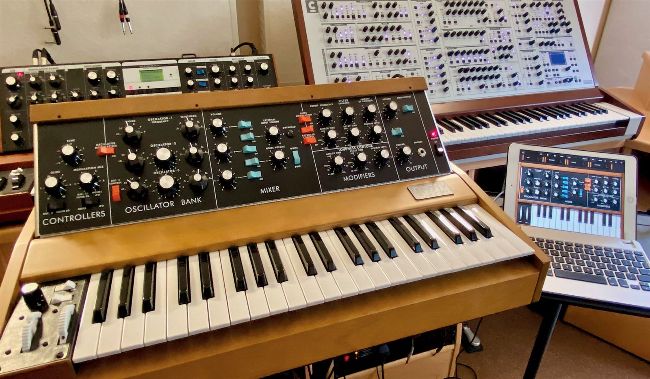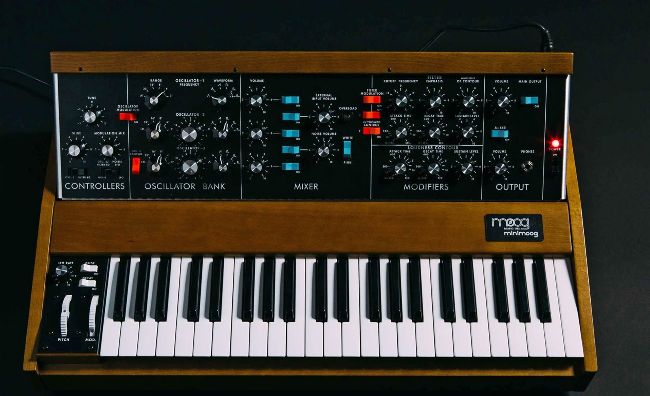Moog Minimoog
It is incredibly fitting that the very first synth for inspection and consideration in our battle of the platforms is arguably the most famous and desired of all monosynths. The Minimoog might not require introduction, but it is certainly worth considering why it garners the reputation that it does, while continuing to be a highly-inspirational object of desire for studio musicians, performers and enthusiasts alike. Enter the legend…
〉We have to start at the very beginning, with the godfather of subtractive synthesis, Robert Moog. The son of an electrical engineer, Bob Moog’s interest in electronic musical instruments started very young. Aged just ten years old, he started building simple radio circuits and other electrical projects, one of which was a threenote electronic organ.
A move to the Bronx High School of Science allowed the teenage Bob to take his interest more seriously, and it was at the tender age of 15 that he built his first Theremin as part of a science fair. Further projects followed, which included more electronic organs and even a Geiger counter, but Bob was utterly captivated by the Theremin, continuing to revise his selfbuilds as part of a business that he started with his father. This fledgling business called Ramco, was renamed in 1954 to R. A. Moog Co. Yet more Theremins followed but one model, called the 351, offered tone shaping capabilities, setting the direction for much greater things to come.
Moog’s debut modules
It was some ten years later that Moog began collaborations with other like-minded individuals, creating early synthesiser modules that would respond to voltage control. These new technologies gained interest from notable composers and experimental musicians, such as John Cage, and formed the blueprint for what would become the first synthesisers which were released in 1967, branded Models I, II & III. Not only were these the first machines of their kind, but they were also instrumental in the introduction of the word ‘synthesiser’ into the musical landscape (although probably ‘synthesizer’ given the US origin).

iOS v hardware v desktop (out of shot). In shot: yes that’s a Schmidt synth. Yes, we’re showing off

The popularity and acceptance of these early modular machines was fairly swift, with early demonstrations of the system from electronic pioneer Wendy Carlos, alongside usage on rock and pop albums by The Doors and The Monkeys. It was the release of the legendary album Switched on Bach in 1968, winning two Grammy Awards the following year, that really cemented the arrival of synthesiser technology, although Bob Moog was unhappy with the original album cover. Portraying J.S. Bach himself, in a slightly giggling-pose in front of a Moog Modular System, the first incarnation of the cover seemed to trivialise the sound that the instrument made, as Bach mugged at the camera, as though he were hearing a strange sound. To make matters worse, the headphones were plugged into the input of a filter, which would have resulted in no sound. The same actor portraying Bach was booked for another photo shoot for a replacement cover. It was reshot in an altogether more serious and stately pose, this time with a correctly connected pair of headphones!
“They were the first machines of their kind, and introduced ‘the synthesiser’”
More Moog access
The two big problems with the original Moog Modular systems were the price and the physical size, both of which were gigantic. Having overcome the extreme cost of the system, you were then merely faced with the practicalities of transporting it from A to B. There was clearly a need for something smaller and more compact, but also something with similar functionality.
In 1970, the Minimoog was born. Also known as the Model D, it offered all the big selling points of the Modular in a form which you could just about carry under your arm… at least you could if you were quite strong; it was an early analogue beast and pretty heavy!
Regardless of its physicality, it was convenient; the Mini offered a panel which could be raised to an angle, with a 44-note keyboard in front of it, so creating sounds was an immediate prospect, requiring no patching with cables. It was a performance synth which quickly became the must-have for a veritable who’s who of pop, rock, jazz and commercial music. Absolutely everyone had to have one…
Setting a blueprint
Moreover, this condensed format became the benchmark for synthesiser design in future years. At the beginning of the signal chain were three Voltage Controlled Oscillators (VCOs), each offering six different waveforms which included triangle, saw and the legendary sharktooth waveform.